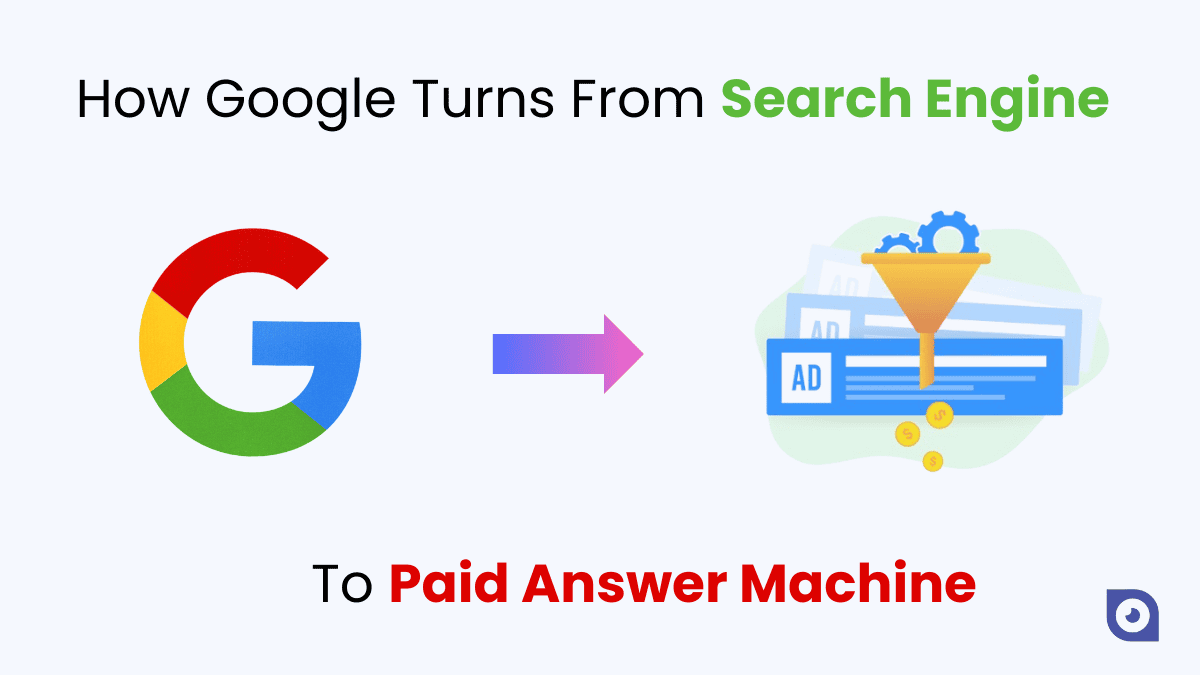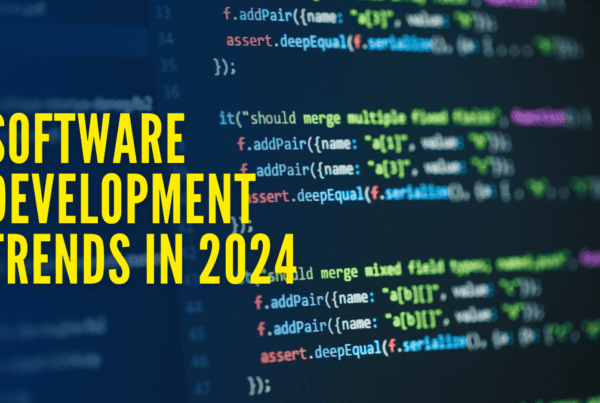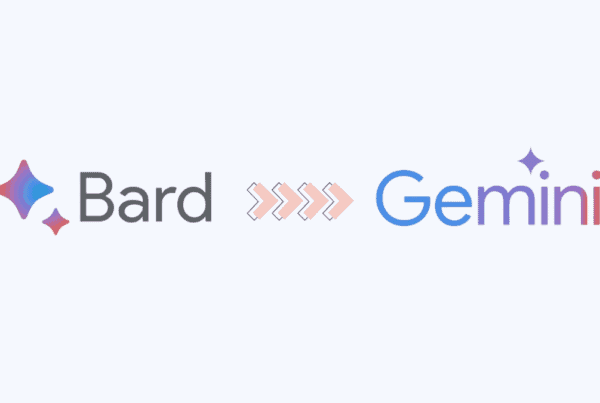
The story of Google begins back in 1998 when two people named Larry Page and Sergey Brin created it. At first, Google was just a basic search engine. Its main goal was to arrange all the information in the world and make it easy for everyone to find and use. But as time passed, Google changed a lot. It went from being a simple search engine to becoming a big system that provides many different services.
Here’s Sergey talking briefly about how the journey began:
The really big change happened when Google started asking for money for answers instead of giving them away for free. It failed, but we are also not talking about that old experiment. The current evolution, we are now at Google SGE and Google Gemini.
In this blog, we will talk about how Google is becoming a Paid Answer Machine. But before that,let’s take a look at the journey of Google till now.
Google’s Journey to Now
When Google first started, its main job was to look at all the web pages out there and put them in order based on what people were looking for.
The computer program that did this, called an algorithm, used really smart math and learning from lots of data to find what people wanted quickly and correctly. Because of this, Google became the go-to place for finding information online, and tons of people trusted it every day.
Getting More Stuff Done
After doing a great job with searching, Google decided to do even more things. They started giving us new tools like Gmail for emails, Google Maps for finding places, Gemini as an AI assitance, and more.
At first, all these new things were free for us to use. But, Google found a clever way to make money by showing ads. Businesses could use Google AdWords to put their ads in front of people who were looking for things online, and this became a big way for Google to make money.
Knowledge Panels and Graph
In 2012, Google did something innovative to become even better at giving helpful answers. They brought in something called the Knowledge Graph. It’s like a giant brain that connects information in a way that’s kind of like how people think.
Knowledge Graphs are like boxes that pop up at the top of the search results and give you a fast look at the important stuff without making you click on a link(i.e. summary). This was the starting point for Google turning into a machine that just gives you answers right away.
![[your-subject] - EyeUniversal](https://www.eyeuniversal.com/wp-content/uploads/2024/07/Knowledge-Graph.png)
Coca-Cola Knowledge Graph on Google
This brain helps Google understand what you’re asking for and gives more detailed answers. This move was a big step for Google, turning it into not just a search engine but a place that doesn’t just find information but also gives you direct answers.
Featured Snippets and BERT Algorithm
Google kept changing to be even more helpful. First, they added short answers at the top of the search results, called featured snippets, and a section where they answered more questions people might have (People also ask section). These answers came from web pages.
In 2018, Google got even smarter with something called the BERT algorithm. It helped Google understand better what people were asking for. So, when you search for something, Google could give you even better and more exact answers. This made the way for businesses and experts to pay and put their answers at the top when people searched for things.
Heading Toward Becoming a Paid Answer Machine
Content creators, SEO experts, and business, website & blog owners are already dealing with around a thousand updates in a year that Google does to its algorithm every year. Additionally, tools that were free until 3 years ago are not free anymore. It is clear evidence of a shift of focus.
Shift of Focus
Over time, Google’s focus shifted towards advertising revenue. The shift from a search-centric to an ad-driven platform was inevitable given the financial potential ads offered, as highlighted by Dare Obansanjo.
YouTube Dominance
One important thing to notice here is that when you search for things online, you often see a lot of YouTube videos at the top of the search results. This makes us wonder if the search results are fair and diverse, especially since YouTube is connected to Google through Alphabet Inc. Also, you might have noticed that there are more and more ads on YouTube these days.
The number of continuous ads on YouTube has changed over time. In the early days of YouTube, there were typically no ads, or at most one ad per video. However, as YouTube became more popular, the number of ads increased.
In 2007, YouTube began allowing advertisers to run two ads per video. In 2010, this was increased to three ads per video. In 2016, YouTube began testing a new format called “bumper ads,” which are six-second non-skippable ads. In 2018, YouTube began allowing advertisers to run up to five ads per video.
The increase in the number of ads on YouTube has been met with criticism from some users. However, YouTube has defended its decision to increase the number of ads, arguing that it is necessary to generate revenue to support the platform.
However, it need to be noted that YouTube offers YouTube premium. so if you don’t want to see ads and this way they are also earning from the users opting for YT premium.
A Failed Experiment: Google Answers
Google has been changing into a place where you pay for answers. They introduced something called Google Answers. It was available from April 2002 to December 2006. On this platform, you can ask questions, and real experts will give you answers. But here’s the catch—you have to pay for those answers. This way, both Google and the experts make money from it.
However, this experiment failed and we hardly know about this now. However, it was a glimpse of what Google wanted to be, an Answer engine.
Development in AI technology and the data Google already has just supported its move.
Nothing is free anymore
Google used to be about finding things, but now it’s more about giving quick answers and keeping you on their search result pages (SERPs). They do this by taking answers or data from other places and showing them to you. If you’re trying to be popular on Google, you might not get many clicks.
It’s similar to how social media keeps stuff on their platforms. Google uses smart computer programs to show pictures and information from other websites. On phones, Google Discover takes the place of the second page of results.
Some people think Google cares more about making money than helping you find things. They’ve changed some free tools, made ads more expensive, and focused on getting money.
My personal opinion is they’re doing this because they might have to split the company because of their monopolistic nature on search. If that happens, they want to make lots of money before it happens.
Competition of AI Tools and Moves Towards a Paid Answer Machine
AI tools are all about the data they have, and the ‘way’ they process this data. Google has a lot of data. The exact amount of data that Google has is not publicly known. However, it is estimated that Google stores between 10 and 15 exabytes of data. An exabyte is equal to 1 million terabytes, or 1 billion gigabytes. This is an incredibly large amount of data, and it is difficult to even comprehend.
Thus, the main problems begin to come to the surface with the rising popularity of AI tools. To stay in the race Google first launched Google Gemini, a conversational AI companion that helps you learn, create, and explore. And now Google is incorporating an AI-based answering engine into its SERPs – Google SGE.
Google’s launch of Google SGE (Search Generative Experience), Gemini, and the increase in the number of ads on SERPs (Search Engine Result Pages) and videos can be seen as a move toward a paid answer machine.
- Google SGE and Gemini are both AI-powered features that provide users with summaries and overview of search results. These features can be helpful for quickly getting a high-level understanding of a topic, but they also have the potential to be used to promote paid content. For example, if a user searches for a product, Google SGE or Gemini might provide them with a summary that includes links to paid product reviews or comparisons.
- The increase in the number of ads on SERPs and videos is another way that Google is making it more difficult for users to find organic (unpaid) content. When users are bombarded with ads, they are more likely to click on an ad instead of an organic result. This can make it difficult for businesses that do not pay for advertising to get their content seen.
Overall, Google’s moves towards a paid answer machine are likely to have a significant impact on the way that users search for information. Users will need to be more aware of the potential for bias in AI-generated content, and they will need to be more careful about clicking on links in search results. My gut feeling is that they will lose their market share to Chatgpt if they don’t find a balance between ads and organic results.
In addition, to the concerns about bias and clickbait, there are also concerns about the impact of Google’s moves on competition. If Google is able to control the flow of information through its AI-powered features, it could make it more difficult for new businesses to compete with established ones.
Google’s moves towards a paid answer machine are a complex issue with both positive and negative potential consequences. It remains to be seen how these changes will ultimately impact users, businesses, and the Internet as a whole.
Google a Plagiarism Machine?
A concerning aspect is the alleged “plagiarism” of content. Google often presents answers directly in search results or Gemini’s research, taking content without proper attribution or compensation. They rephrase the content to align with the question asked or task given. This raises ethical and copyright concerns among creators.
When I asked Google Gemini “How does Gemini provide content ?”
Its response was “Gemini generates content using a massive dataset. It learns patterns and predicts the next word based on your prompt. This creates various text formats like stories, poems, scripts, and translations. Remember, it’s a generative AI, so its output might not always be accurate.”

Let’s say you ask Gemini, “What’s the tallest mountain in the world?” Gemini starts by looking at all the information it has in its big collection of words and code.
It finds out that Mount Everest in the Himalayas is the tallest mountain. Then, it uses its smarts to put that information into a nice, understandable answer for you. So, Gemini would tell you, “The tallest mountain in the world is Mount Everest, which is located in the Himalayas.”
It’s like having a super knowledgeable friend who can find the best answers to your questions and explain them in a way you can understand.
Gemini is like a super-smart computer program. It learns from lots of books, websites, and other things. So, it can make things that are true and interesting to read. But, remember, it’s not a person, so there’s a chance it might copy things from others.
To prevent copying, Gemini tries to make its own stuff. But because it learns from what’s already out there, it might still look like something someone else wrote. That’s why it’s important to double-check the things Gemini makes.
Let me break it down for you.
Imagine Gemini is like a helpful robot writer. It has read many books and websites to learn about different topics.
Now, you ask Gemini to write a short essay about the Eiffel Tower. Gemini thinks for a moment and starts writing about how tall the Eiffel Tower is, its history, and why people love it. It’s trying to make its own words based on what it learned.
However, because Gemini read so much, its essay might look a bit like something you find in a book or on a website. It’s as if the robot wrote, “The Eiffel Tower stands 324 meters tall and was built in 1889,” which is accurate but could be similar to what someone else wrote.
So, to be sure it’s not too similar to others’ writing, you should check what Gemini makes to avoid any issues with copying.
So, What is the Problem here?
Yes, I understand, Google and other AI tools are all engaged in similar activities. They all need money to continue being attractive to users, to operate their services, and to manage their day-to-day functions effectively.
So, what is wrong here?
What were the compensation and rewards received by individuals who contributed data, authored blogs, and conducted research?
Stealing Earnings of Content Writers
Google doesn’t make people visit websites any more. They put everything you need on their search results pages. This can make it hard for website owners to make money because fewer people visit their sites. So, no income through Adsense, affiliate links, banners, etc. However, Searchers are still getting what they want “on Google’s SERPs”. Remember, Google SERPs feature a lot of ads, and a lot of content “written and published by content creators”.
Google earns money from these ads but content creators earn nothing from here other than clicks (visitors), but now when Google is making everything available on their SERPs, content creators are also losing those much-needed clicks and visitors.
Reducing the Moral of Content Creators
On one hand, Google is making it tough for people who own websites or write authentic and well-researched content. They do this by putting all the information on the Google search pages itself. So, not as many people visit websites, and website owners can’t make as much money.
On the other hand, there are AI tools that let people create a lot of content easily, even if they aren’t experts. They don’t need to do a lot of research or have much knowledge.
And here’s the thing: the more content you have, the better your website can show up in Google. This can be a problem because it takes the spotlight away from the original content creators who work hard and know a lot about their topics. So, they might lose interest and not want to create content anymore.
Plagiarised Content Everywhere
In the past, folks used to be worried about sharing content that was just reworded, copied, or stolen from others. But now, it seems like things have shifted, and Google is part of this change. Google has tools that create content by using stuff that’s already out there, like what content writers have written.
So, it’s like Google is saying it’s okay to use existing content to make new stuff, which is different from how it used to be when people were scared to do that.
What is the Solution?
It seems pretty clear that Google won’t change its way. It wants to be a “Paid Answer Engine”, where those who pay them get more websites, visitors, and potential customers. Google doesn’t seem to mind if the content is rephrased or made by AI (its AI is not sophisticated to know other AI writes content).
This direction might hurt content writers and businesses that want to grow naturally and genuinely. Right now, there aren’t any fixes for these problems. We just have to keep going and adapt to this changing world.
Conclusion
Google’s transformation from a search engine to a paid answer machine reflects the evolving dynamics of the digital landscape. The integration of sophisticated algorithms, machine learning, and a commitment to providing direct and concise answers has reshaped how users interact with the platform.
As Google continues to explore new revenue streams, the balance between providing valuable information and monetizing expertise will be a key challenge for the company in the coming years.



